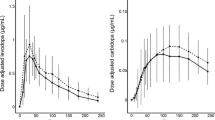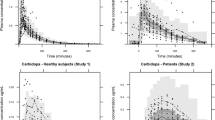Abstract
The purpose of this analysis is to describe how levodopa pharmacokinetic and pharmacodynamic parameters change over the first 4 years of long-term levodopa treatment in patients with Parkinson’s disease. Twenty previously untreated Parkinsonian patients were admitted to the general clinical research center (GCRC) for 4 days at the beginning of long-term levodopa therapy and 6, 12, 24 and 48 months later. On each GCRC admission, patients received a 2 hr IV infusion of levodopa on day 1 and day 4 with no oral levodopa between the infusions. After the first GCRC admission patients were treated with oral levodopa dosed for optimal control of Parkinsonism. Motor function was measured by finger tapping rate. A pharmacokinetic–pharmacodynamic model incorporating 3 effect compartments was used to fit the individual plasma levodopa concentrations and tapping rates. Motor function before the first levodopa infusion (E01) improved over the first 20 months and subsequently returned to the initial baseline at the start of the study. A similar pattern was seen in motor function before the second infusion (E02) after the 3 days levodopa withdrawal, with a decline predicted to fall below the initial baseline at the start of the study by 6 years. Eight patients showed an increase in maximum tapping rate with levodopa (E max ) approaching a steady state after 16 months. Ten patients showed an increase in E max with a peak at 31 months. One patient showed a linear decrease and another patient did not change over the 48 months. Longitudinal progress models were used to describe the time course of pharmacokinetic and pharmacodynamic parameters over 4 years. Peak treatment benefit, defined as the difference between E max and E01 or E02 (D max 1 or D max 2), increased with time particularly after the 3-day levodopa withdrawal. Deterioration of pre-dose motor function (E0) as disease progresses coupled with a greater amplitude of response due to levodopa (D max ) could be a key factor contributing to motor fluctuations associated with long-term levodopa treatment.
Similar content being viewed by others
References
G.C. Cotzias M.H. Woert ParticleVan L.M. Schiffer (1967) ArticleTitleAromatic amino acids and modification of parkinsonism N. Engl. J. Med. 276 374–379 Occurrence Handle5334614 Occurrence Handle1:CAS:528:DyaF2sXnsVymsQ%3D%3D Occurrence Handle10.1056/NEJM196702162760703
M.D. Muenter G.M. Tyce (1971) ArticleTitleL-dopa therapy of Parkinson’s disease, plasma L-dopa concentration, therapeutic response, and side effects Mayo. Clin. Proc. 46 231–239 Occurrence Handle5573818 Occurrence Handle1:STN:280:DyaE3M7osVSrsQ%3D%3D
C.L. Comella J. Bohmer G.T. Stebbins (1995) ArticleTitleSleep benefit in Parkinson’s disease (Abstract) Mov. Disord. 45 A286
L.J. Currie J.P. Bennett SuffixJr. M.B. Harrison J.M. Trugman G.F. Wooten (1997) ArticleTitleClinical correlates of sleep benefit in Parkinson’s disease Neurology 48 1115–1117 Occurrence Handle9109914 Occurrence Handle1:STN:280:DyaK2s3msVSnsA%3D%3D
M. Merello A. Hughes C. Colosimo M. Hoffman S. Starkstein R. Leiguarda (1997) ArticleTitleSleep benefit in Parkinson’s disease Mov. Disord. 12 506–508 Occurrence Handle10.1002/mds.870120405 Occurrence Handle9251067 Occurrence Handle1:STN:280:DyaK2szpsVOmtg%3D%3D
J.E. Ahlskog M.D. Muenter (2001) ArticleTitleFrequency of levodopa-related dyskinesias and motor fluctuations as estimated from the cumulative literature Mov. Disord. 16 448–458 Occurrence Handle11391738 Occurrence Handle1:STN:280:DC%2BD3MzitVCmtg%3D%3D
C.D. McColl K.A. Reardon M. Shiff P.A. Kempster (2002) ArticleTitleMotor response to levodopa and the evolution of motor fluctuations in the first decade of treatment of Parkinson’s disease Mov. Disord. 17 1227–1234 Occurrence Handle10.1002/mds.10244 Occurrence Handle12465061
J.G. Nutt W.R. Woodward J.P. Hammerstad J.H. Carter J.L. Anderson (1984) ArticleTitleThe “on-off” phenomenon in Parkinson’s disease. Relation to levodopa absorption and transport N. Engl. J. Med. 310 483–488 Occurrence Handle6694694 Occurrence Handle1:STN:280:DyaL2c7hsleqtw%3D%3D Occurrence Handle10.1056/NEJM198402233100802
G. Fabbrini J. Juncos M.M. Mouradian C. Serrati T.N. Chase (1987) ArticleTitleLevodopa pharmacokinetic mechanisms and motor fluctuations in Parkinson’s disease Ann. Neurol. 21 370–376 Occurrence Handle10.1002/ana.410210409 Occurrence Handle3579222 Occurrence Handle1:STN:280:DyaL2s3htFOqsQ%3D%3D
G. Fabbrini M.M. Mouradina J.L. Juncos J. Schlegel E. Mohr T.N. Chase (1988) ArticleTitleMotor fluctuations in Parkinson’s disease: central pathophysiological mechanisms, Part I Ann. Neurol. 24 366–371 Occurrence Handle3228270 Occurrence Handle1:STN:280:DyaL1M7kvFSjtQ%3D%3D
M.M. Mouradian T.N. Chase (1988) ArticleTitleCentral mechanisms and levodopa response fluctuations in Parkinson’s disease Clin. Neuropharmacol. 11 378–385 Occurrence Handle3061637 Occurrence Handle1:STN:280:DyaL1M%2FovFKmtg%3D%3D
P.L.S. Chan J.G. Nutt N.H.G. Holford (2004) ArticleTitleModeling the short- and long-responses to exogenous levodopa and to endogenous levodopa production in Parkinson’s disease J. Pharmacokinet. Pharmacodyn. 31 243–268 Occurrence Handle10.1023/B:JOPA.0000039566.75368.59 Occurrence Handle15518246 Occurrence Handle1:CAS:528:DC%2BD2cXntVKru7o%3D
J.G. Nutt J.H. Carter E.S. Lea G.J. Sexton (2002) ArticleTitleEvolution of the response to levodopa during the first 4 years of therapy Ann. Neurol. 51 686–693 Occurrence Handle10.1002/ana.10189 Occurrence Handle12112073 Occurrence Handle1:CAS:528:DC%2BD3sXhsFygsbw%3D
Chan P.L.S., Nutt J.G., Holford N.H.G. Importance of within subject variation in levodopa pharmacokinentics: a 4 year cohort study in Parkinson’s disease. J. Pharmacokinet. Pharmacodyn. In press (2005).
Holford N.H.G. MKMODEL - Extended Least Squares Non-Linear Regression and Modelling Worksheet for IBM PC.In. 5th edn, Elsevier-BIOSOFT, 1994.
Beal S.L., Boeckmann A.J., and Sheiner L.B.,. NONMEM Project Group. NONMEM Users Guides. In. Version V edn, University of California at San Francisco, San Francisco, 1999.
U. Wählby E.N. Jonsson M.O. Karlsson (2001) ArticleTitleAssessment of the actual significance levels for covariate effects in NONMEM J. Pharmacokinet. Pharmacodyn. 28 23–252
J.V.S. Gobburu J. Lawrence (2002) ArticleTitleApplication of resampling techniques to estimate exact significance levels for covariate selection during nonlinear mixed effects model building: some inferences Pharm. Res. 19 92–98 Occurrence Handle10.1023/A:1013615701857 Occurrence Handle11841044 Occurrence Handle1:CAS:528:DC%2BD38XhtVSmtr4%3D
J.G. Nutt W.R. Woodward J.H. Carter S.T. Gancher (1992) ArticleTitleEffect of long-term therapy on the pharmacodynamics of levodopa Relation to on-off phenomenon. Arch. Neurol. 49 1123–1130 Occurrence Handle1:STN:280:DyaK3s%2FnsVGisQ%3D%3D
M. Contin R. Riva P. Martinelli A. Baruzzi (1993) ArticleTitlePharmacodynamic modeling of oral levodopa: clinical application in Parkinson’s disease Neurology 43 367–371 Occurrence Handle8437704 Occurrence Handle1:STN:280:DyaK3s7ntleisA%3D%3D
S. Harder H. Baas (1998) ArticleTitleConcentration-response relationship of levodopa in patients with different stages of Parkinson’s disease Clin. Pharmacol. Ther. 64 183–191 Occurrence Handle10.1016/S0009-9236(98)90152-7 Occurrence Handle9728899 Occurrence Handle1:CAS:528:DyaK1cXlvVyksr8%3D
M. Contin R. Riva P. Martinelli P. Cortelli F. Albani A. Baruzzi (1994) ArticleTitleLongitudinal monitoring of the levodopa concentration-effect relationship in Parkinson’s disease Neurology 44 1287–1292 Occurrence Handle8035932 Occurrence Handle1:STN:280:DyaK2czgvFyisQ%3D%3D
M. Contin R. Riva P. Martinelli F. Albani A. Baruzzi (1997) ArticleTitleRelationship between levodopa concentration, dyskinesias, and motor effect in parkinsonian patients – a 3-year follow-up study Clin. Neuropharmacol. 20 409–418 Occurrence Handle9331517 Occurrence Handle1:CAS:528:DyaK2sXmslWqtL4%3D
J.G. Nutt J.H. Carter W.R. Woodward (1994) ArticleTitleEffect of brief levodopa holidays on the short-duration response to levodopa. Evidence for tolerance to the antiparkinsonian effects Neurology 44 1617–1622 Occurrence Handle7936285 Occurrence Handle1:STN:280:DyaK2M%2Fit1anuw%3D%3D
M. Zappia R.L. Oliveri R. Montesanti M. Rizzo D. Bosco M. Plastino L. Crescibene L. Bastone U. Aguglia A. Gambardella A. Quattrone (1999) ArticleTitleLoss of long-duration response to levodopa over time in PD: implications for wearing-off Neurology 52 763–767 Occurrence Handle10078724 Occurrence Handle1:CAS:528:DyaK1MXhvFGgsbw%3D
R.A. Hauser N.H.G. Holford (2002) ArticleTitleQuantitative description of loss of clinical benefit following withdrawal of levodopa–carbidopa and bromocriptine in early Parkinson’s disease Mov. Disord. 17 961–968 Occurrence Handle12360545
M. Contin P. Martinelli R. Riva M. Dondi S. Fanti C. Pettinato C. Scaglione F. Albani A. Baruzzi (2003) ArticleTitleAssessing dopaminergic function in Parkinson’s disease: levodopa kinetic–dynamic modeling and SPECT J. Neurol 250 1475–1481 Occurrence Handle10.1007/s00415-003-0257-3 Occurrence Handle14673582 Occurrence Handle1:CAS:528:DC%2BD2cXitVejt7o%3D
M. Dietz S. Harder J. Graff G. Kunig P. Vontobel K.L. Leenders H. Baas (2001) ArticleTitleLevodopa pharmacokinetic–pharmacodynamic modeling and 6-[18F]levodopa positron emission tomography in patients with Parkinson’s disease Clin. Pharmacol. Ther. 70 33–41 Occurrence Handle10.1067/mcp.2001.116328 Occurrence Handle11452242 Occurrence Handle1:CAS:528:DC%2BD3MXlvFKru7s%3D
M. Contin R. Riva P. Martinelli G. Procaccianti P. Cortelli P. Avoni A. Baruzzi (1990) ArticleTitleResponse to a standard oral levodopa test in parkinsonian patients with and without motor fluctuations Clin. Neuropharmacol. 13 19–28 Occurrence Handle2306746 Occurrence Handle1:STN:280:DyaK3c7mslOiug%3D%3D
Y.H. Sohn L.V. Metman D. Bravi I. Linfante A. Aotsuka M.M. Mouradian T.N. Chase (1994) ArticleTitleLevodopa peak response time reflects severity of dopamine neuron loss in Parkinson’s disease Neurology. 44 755–757 Occurrence Handle8164839 Occurrence Handle1:STN:280:DyaK2c3hsl2itg%3D%3D
J.G. Nutt N.H.G. Holford (1996) ArticleTitleThe response to levodopa in Parkinson’s disease: imposing pharmacological law and order Ann. Neurol. 39 561–573 Occurrence Handle10.1002/ana.410390504 Occurrence Handle8619540 Occurrence Handle1:CAS:528:DyaK28XjsFags7w%3D
C.H. Markham S.G. Diamond (1981) ArticleTitleEvidence to support early levodopa therapy in Parkinson disease Neurology 31 125–131 Occurrence Handle7193296 Occurrence Handle1:STN:280:DyaL3M7itlejuw%3D%3D
C.H. Markham S.G. Diamond (1986) ArticleTitleModification of Parkinson’s disease by long-term levodopa treatment Arch. Neurol. 43 405–407 Occurrence Handle3082316 Occurrence Handle1:STN:280:DyaL287lvVChtA%3D%3D
C. D. Marsden and J. D. Parkes. Success and problems of long-term levodopa therapy in Parkinson’s disease. Lancet 345–349 (1977).
J.G. Nutt J.H. Carter L. Van Houten W.R. Woodward (1997) ArticleTitleShort- and long-duration responses to levodopa during the first year of levodopa therapy Ann. Neurol. 42 349–355 Occurrence Handle10.1002/ana.410420311 Occurrence Handle9307256 Occurrence Handle1:CAS:528:DyaK2sXmt1yjtbw%3D
J.G. Nutt J.H. Carter (2000) ArticleTitleApomorphine can sustain the long-duration response to L-DOPA in fluctuating PD Neurology 54 247–250 Occurrence Handle10636162 Occurrence Handle1:CAS:528:DC%2BD3cXoslSgug%3D%3D
F. Stocchi L. Vacca A. Berardelli F. De Pandis S. Ruggieri (2001) ArticleTitleLong-duration effect and the postsynaptic compartment: study using a dopamine agonist with a short half-life Mov. Disord. 16 301–305 Occurrence Handle10.1002/mds.1070 Occurrence Handle11295785 Occurrence Handle1:STN:280:DC%2BD3MvotlKnuw%3D%3D
T.D. Reisine J.Z. Fields H.I. Yamamura (1977) ArticleTitleNeurotransmitter receptor alterations in Parkinson’s disease Life Sci. 21 335–343 Occurrence Handle197361 Occurrence Handle1:CAS:528:DyaE2sXltFKjs74%3D
T. Lee P. Seeman A. Rajput I.J. Farley O. Hornykiewicz (1978) ArticleTitleReceptor basis for dopaminergic supersensitivity in Parkinson’s disease Nature 273 59–61 Occurrence Handle10.1038/273059a0 Occurrence Handle692671 Occurrence Handle1:CAS:528:DyaE1cXlsVClt7c%3D
Author information
Authors and Affiliations
Corresponding author
Rights and permissions
About this article
Cite this article
Chan, P.L.S., Nutt, J.G. & Holford, N.H.G. Pharmacokinetic and Pharmacodynamic Changes During the First Four Years of Levodopa Treatment in Parkinson’s Disease. J Pharmacokinet Pharmacodyn 32, 459–484 (2005). https://doi.org/10.1007/s10928-005-0055-x
Received:
Accepted:
Issue Date:
DOI: https://doi.org/10.1007/s10928-005-0055-x




